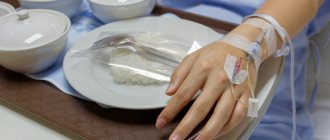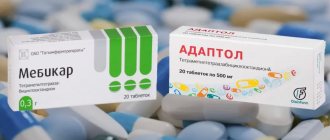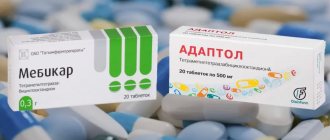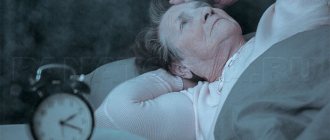Depression is a pressing problem; the number of visits to doctors is growing every year. It can be solved by contacting a psychotherapist and taking antidepressants . These are medications that regulate the production of hormones and biochemical processes in the body. to prescribe them to yourself, since these are complex drugs with certain restrictions and side effects . The doctor must authorize their use and supervise their use. We will tell you which of them are the most effective and common in medicine, and how many pros and cons they have.
What is meant by depression
Doctors have been familiar with it since the times of Ancient Greece and Egypt. Hippocrates described it as melancholy - a condition that is accompanied by anxiety, despondency, insomnia, refusal of food, and irritability. Most often, the cause is childhood trauma or severe, frequent stress in adulthood. There are many provoking factors: the death of a loved one, worsening living conditions, alcoholism, brain diseases. Such cases are referred to as psychogenic depression.
The second type is endogenous. The problem does not arise from major external shocks, but from internal causes. A person is constantly dissatisfied with himself and exposes himself to criticism. Many patients have panic attacks and are haunted by feelings of fear and anxiety.
Manifestations
Depressive manifestations as such can be a natural, timely reaction to unfavorable events in life that do not depend on a person’s will, in the case of, for example, the death of loved ones, loss of a job, or witnessing negative events (violence, military conflict, discrimination, etc.) or participation in them.
Some patients are characterized by pessimistic beliefs about their low social significance and a distorted perception of their achievements towards underestimation. As a rule, this is associated with beliefs that arise in childhood and are activated in adulthood as a result of certain experiences that gave impetus to the onset of a depressive state. In such cases, there is a constant distortion of events, inadequate perception of events based on random conclusions, a desire for a hypothetical absolute and a refusal to consider a compromise, conformal option.
Depression can also be observed in numerous somatic diseases: neurological, endocrine and others (viral, pulmonary, etc.), atherosclerosis, diabetes mellitus, stroke, Parkinson’s disease, vitamin deficiencies, neoplasms, Alzheimer’s disease, influenza, as well as in traumatic brain injuries, in case of malfunction of the body or as a side effect of treatment and use of medications, sleeping pills.
Even in ancient medicine, cases of melancholy were known, the symptoms of which are recognizable in the modern understanding of depressive mental disorder (its seasonality, dependence on weather, sunlight, etc.). Both with pronounced depression and with its implicit form, a person loses interest and the will to live, to actively realize life, self-esteem drops sharply, and a period of constant depression and apathy sets in. Often, in search of a way out of this condition, a person turns to alcohol abuse and/or psychotropic drugs, which in turn leads to worsening depressive disorder.
There are effective pharmacotherapeutic and psychotherapeutic methods for treating depression, but the variety of its manifestations and factors leading to it, the very attitude towards “bad mood” in society, the habit of controlling one’s emotions make it difficult to diagnose it in a timely manner: patients do not report symptoms of depression and are prejudiced against depression. prescription of antidepressants and are afraid of side effects from their use. But only a timely diagnosis made by a doctor can stop the process and prevent further development of depression into a severe form.
How is depression treated?
Depression has been treated in different ways. In the ancient world - emetics and laxatives. In the Renaissance - wine and sunbathing. In the Age of Enlightenment - external irritants, for example, insects. The 19th century brought new recipes - in particular, a solution of camphor in tartaric acid. The treatment also included taking drugs that are now no longer allowed for sale, and some are recognized as narcotic.
Obviously, all these drugs had no effect on increasing the amount of serotonin. And the treatment consists precisely in normalizing its production. This was done after the creation of modern antidepressants , which have a minimum of side effects, are safe for the body and are not addictive. These are medications action is aimed specifically at equalizing the disturbed balance of neurotransmitters: serotonin, norepinephrine, dopamine.
Diagnosis and symptoms of depression
The diagnosis of depression is made on the basis of criteria for a mental disorder (mood disorder): screening (preventive examination and surveys), a self-assessment test for depressive state (Zang scale), medical assessment and analysis of individual symptoms inherent in a depressive state (anxiety, suicidal thoughts, etc.). ).
According to the ICD-10 criteria (the official diagnostic criteria adopted in the Russian Federation), depressive symptoms are distinguished as main and additional. Thus, to diagnose depression, it is necessary to observe two main and at least three additional symptoms. All main symptoms appear continuously over a long period of time (from two weeks). If the symptoms are clearly expressed and occur in a severe form, the diagnosis can be made in the case of shorter periods of their manifestation.
The main symptoms of depression are considered: constantly bad mood and depression; what previously brought pleasure no longer arouses interest and does not bring any satisfaction; chronic state of fatigue.
Additional symptoms include the following: anxiety, fears, recognition of one’s existence as devoid of any benefit or meaning, feelings of guilt; low self-esteem; inability to make decisions and concentrate; thoughts about death and suicidal thoughts; lack of appetite or excessive absorption of food; sleep disorders (insomnia or, conversely, excessively long sleep).
The DSM-IV-TR diagnosis of depression (valid in the United States and some other English-speaking countries) includes two main symptoms: depressed mood and an inability to experience pleasure accompanied by a loss of interest in a subject and/or activity. In addition to these two, nine other symptoms are considered: sadness (for childhood and adolescence, this can take the form of irritability); loss of interest in all/almost all types of activities; weight loss and lack of appetite or increased appetite and weight gain; short and intermittent sleep or excessive daytime sleepiness; motor retardation or excitability; chronic fatigue due to decreased activity; a feeling of one’s own uselessness and uselessness, low self-esteem, an exaggerated sense of guilt; slowness of thought processes and decreased concentration; suicidal tendencies.
When diagnosing depression, the DSM-IV-TR defines a two-week period of onset during which at least five of the nine symptoms must be present, and these must include at least one of the core symptoms.
"A difficult age".
Lecture by Anna Melnikova and Kristina Kurosh We’ll talk with psychiatrist Anna Melnikova and medical psychologist Kristina Kurosh about teenage depression, behavioral disorders, self-harm and other alarm bells of the pubertal crisis and whether it’s always worth waiting for a teenager to “get mad.”
Purpose
If a healthy person takes antidepressants, there will be no effect . Taking them will help a patient with depression:
- improve psychological state;
- get rid of irritability;
- panic fear;
- increase mental and physical activity;
- overcome sad mood.
Psychiatrists prescribe antidepressants for chronic back pain and headaches. And also for irritable bowel syndrome, incontinence and other cases when the body stops producing its own painkillers. Taking medications helps restore pain suppression mechanisms.
take these medications only with a doctor's prescription, since many of them are strong stimulants . Self-prescription may be expensive and may worsen the condition. Only a doctor will correctly calculate how much medicine to take per day. with a psychotherapist is required .
How can we help?
| If you have discovered some of the described symptoms, this may indicate the development of a mental disorder. In this case, it is worth contacting a psychiatrist for diagnosis and initiation of timely treatment. In addition to face-to-face appointments , we offer a remote consultation service (online) , which is not inferior in quality to a personal meeting. Thus, you can receive qualified assistance from a high-level specialist, no matter where you are. |
Our clinic, near the Eastern Administrative District of Moscow, in Reutov, employs specialists who have extensive experience in treating mental disorders. We use the most modern and advanced techniques, guided by the principles of evidence-based medicine. Effective assistance and confidentiality of information constituting medical confidentiality are guaranteed.
Precautionary measures
- They start taking the prescribed drug with a small dose - for the first couple of days they take a quarter of a tablet. Gradually the dose is increased to normal. This way the body adapts better. The course is completed by reducing the dose.
- The first effect appears only 2 weeks after the start of treatment. Sustained action - after six months. All this time you need to take the drug without skipping or breaks.
- The products cannot be combined with melatonin, St. John's wort, products and dietary supplements based on sibutramine, 5-NTR. The combination of the two can increase serotonin to dangerous levels. They also cannot be combined with monoamine oxidase inhibitors. When writing a prescription , the doctor takes these points into account.
- to take antidepressants in parallel with visits to a psychotherapist. If the drugs normalize the biochemical processes in the body, then this doctor will help normalize the psychological state after depression.
Depression and its somatic manifestations
An ailment whose cause should long ago be found, Similar to the English spleen, In short: Russian blues...
A. S. Pushkin. "Eugene Onegin"
Depression is one of the most serious problems in modern health care. WHO experts have calculated that by 2021 depression will be one of the main causes of disability and will take second place after cardiovascular disease [22]. Despite the significance of the problem, in most cases in general practice, insufficient attention is paid to the diagnosis and treatment of depression. The prevalence of depression is yet to be determined, as epidemiological studies to date have used different definitions and different criteria for depression, thus leaving a significant number of such patients under-reported. The lifetime incidence of depression is 5–12% in men and 12–20% in women [21].
The term “depression” is not entirely correct; in general practice it is better to use the broader term “depressive disorders”. According to the DSM-IV classification, depressive disorders are divided into major depressive disorder (which is divided into several categories), dysthymia, and depressive disorders not meeting the classification definition (divided into six subtypes). Major depression is the most severe manifestation of depressive disorders, most often encountered in psychiatric practice.
Depressive disorders occur in 20–25% of general practitioner patients [31]. Depressive disorders can also be a direct manifestation of a somatic illness. “Myxoedema insanity” has been described in the literature since the 19th century, and depression is the most typical psychiatric symptom of hypothyroidism [15]. Depressive disorders can occur with long-term anemia and rheumatoid arthritis. Depression can be caused by taking certain medications, primarily interferon-alpha, glucocorticoids, and reserpine. However, somatic symptoms can be a direct manifestation of depression. To define the somatic symptoms of depression, there are a large number of terms in the literature: somatic, somatized, physical, bodily, somatoform, pain, psychosomatic, vegetative, medically unexplained, masked, etc.
In a study by Ohayon MM et al. [24] studied the prevalence of various disorders in patients with depression who were seen by a general practitioner. From Fig. 1 shows that the majority of patients with depression have somatic problems or chronic pain syndrome, with which they turn to general practitioners. In another clinical study of 573 patients diagnosed with major depression, two-thirds (69%) of them complained of a variety of pain, which was closely associated with depression [7].
Single somatic symptoms are the main reason for visits to an internist in more than 50% of patients with depression. In 20–25% of cases, these symptoms are recurrent or chronic [24]. Kroenke K. et al. studied the cause of the most frequent complaints of patients visiting a general practitioner over a three-year period and came to the conclusion that most of them do not have an organic basis (
). Another large-scale multicenter study (1146 people) conducted by WHO confirmed that two-thirds of patients with depression and physical illness were dominated by multiple, medically unexplained physical symptoms.
Meanwhile, a significant number of patients with depression remain undiagnosed for this disease. There are a number of reasons for the underdiagnosis of depressive disorders in general practice: the predominance of many somatic symptoms and the absence of complaints about mental ill-being. Doctors often mistakenly view depression as a natural response to stressful life events or a physical illness. However, depression can be comorbid with an underlying neurological or somatic disease. As shown in the European Study Society study (DEPES II) [31], 65% of patients with depression in the general medical network suffer from a concomitant disease, which causes certain difficulties in formulating a diagnosis.
Practicing physicians are well aware that clinical manifestations of depressive disorders often do not meet established diagnostic criteria, since they manifest themselves as recurrent symptoms of shorter duration than indicated in the classification. Subsyndromal manifestations of depressive disorders are not sufficiently diagnosed due to the polymorphism of their manifestations. Most often, subsyndromal depressive disorders are manifestations of “partially treated” syndromic depressive disorders that aggravate the course of the underlying disease. For example, subsyndromal depressive disorder occurs in 20–45% of patients who have suffered a myocardial infarction [30].
Of all the diagnostically significant manifestations of depression, two key symptoms of a current depressive episode are of a somatic nature: fatigue/weakness/apathy is observed in 73% of patients, insomnia/drowsiness is observed in 63%. In the Gerber PD study [12], some somatic symptoms showed a high predictive value for a positive diagnosis of depression: sleep disturbances (61%), fatigue (60%), the presence of three or more complaints (56%), nonspecific musculoskeletal complaints (43%). ), back pain (39%), vaguely formulated complaints (37%). Multiplicity of vague complaints is the most reliable clinical correlate of depressive disorder. A study of 1000 patients visiting general practitioners showed that only 2% of patients with depression have one of the somatic symptoms, and 60% of patients have 9 or more somatic manifestations of the disease [31]. The multiplicity and polysystemic nature of the somatic manifestations of depression is considered one of the main reasons for its low detection rate in primary care. One additional tool for diagnosing physical symptoms of depression is the Somatic Symptom Inventory (SSI) (
.) [29].
Each symptom is rated on a 5-point scale (1 - none, 2 - mild, 3 - moderate, 4 - severe, 5 - very severe). A total score of 52 or more may indicate the presence of somatic symptoms of depression [29].
Depression is the main clinical manifestation of seasonal affective disorder, often encountered in general practice. With seasonal affective disorder, clinical symptoms occur exclusively in the dark season - from late October to early March, and with the advent of the light season, all symptoms spontaneously disappear. Depression in seasonal affective disorder is usually mild and is manifested by decreased mood, dissatisfaction with oneself, depression, a constant feeling of fatigue, decreased performance, and a decrease in the ability to have pleasure [1]. Severe social maladaptation and suicidal attempts are not typical. Associated symptoms such as drowsiness, premenstrual tension syndrome, bulimia with an addiction to high-carbohydrate, quickly digestible foods and an increase in body weight of 3–5 kg are typical. Sleep disorders are very specific: there is both daytime sleepiness and an increase in the duration of night sleep, while, despite a long night's sleep, in the morning patients wake up sleep-deprived, exhausted and drowsy, which is why such sleep is called “non-restorative” [1].
Premenstrual tension syndrome is closely related to seasonal affective disorder and is also based on depressive disorders. Premenstrual tension syndrome is characterized by mild or moderate depression with a predominance of somatic manifestations, which does not lead to pronounced maladjustment. In the case of severe mental disorders and maladaptation of patients (difficulties in study or work, reduced social activity, disruption of interpersonal relationships), they speak of premenstrual dysphoric disorder.
The key criteria for diagnosing premenstrual tension syndromes and premenstrual dysphoric disorder are [1]:
- a clear association of all pathological clinical symptoms with the luteal phase of the cycle (2–14 days before menstruation);
- spontaneous reduction of all clinical symptoms immediately after the onset of menstruation;
- mandatory complete absence of clinical symptoms in the first week after menstruation;
- the regular appearance of somatic and psychopathological symptoms in the luteal phase of most of a woman’s cycles over the past year.
The clinical picture of premenstrual tension syndrome includes more than 100 somatic and mental manifestations, but depressive disorders are obligate. Among the mental symptoms are decreased, depressed, depressed mood; increased irritability; grouchiness, anger, conflict; fatigue and lack of energy; aggressiveness and hostility; touchiness and tearfulness; feeling of constant internal tension and anxiety; difficulties in concentrating and reduced performance [1]. Characterized by severe mood swings with bouts of tearfulness. Patients feel that their life has lost its meaning; they begin to feel helpless and useless, hopeless and futile. Along with emotional and affective disorders, premenstrual tension syndrome almost always involves disturbances in the motivational sphere: sleep disturbances, manifested as both insomnia and hypersomnia disorders. Patients report difficulty falling asleep, frequent awakenings at night, early morning awakenings, morning lack of sleep and daytime sleepiness. Sexual desire decreases, appetite increases, attacks of bulimia with a special craving for sweet, high-carbohydrate foods are observed, and unusual food cravings may appear [1]. Among the somatic complaints of patients with premenstrual tension syndrome, one can highlight enlargement and engorgement of the mammary glands, a feeling of heaviness and pain in the lower abdomen and lower back, puffiness, a feeling of swelling of the whole body, weight gain, pain in muscles, joints, headaches, non-systemic dizziness, hot flashes , flatulence, constipation, tachycardia, increased sweating.
For the specific treatment of mood disorders, in particular depression, doctors have used St. John's wort (Hypericum perforatum) preparations for centuries. The plant gets its Latin name from the words “hyper,” excessively, and “eikon,” vision. St. John's wort was first used to treat "melancholy" by the English astrologer and herbalist Nichols Culpeper in 1652 [10]. Today, preparations based on St. John's wort extract are the most commonly prescribed drugs for the treatment of depression in Europe, and in the United States in 2002, 12% of the population took preparations based on Hypericum perforatum.
St. John's wort extract has a complex biochemical composition. Hyperforin, which belongs to the class of flavanoids, is a substance that determines the antidepressant effect of St. John's wort preparations [8]. Hyperforin in doses contained in St. John's wort extract inhibits the reuptake of serotonin, norepinephrine and dopamine [23], and also increases cortisol levels [11], stimulates the formation of serotonin in brain neurons and affects the GABAergic and glutamatergic systems of the brain [32]. In small doses, hyperforin stimulates the release of acetylcholine, and in large doses it inhibits its reuptake [9]. This effect has also been noted in clinical practice: unlike synthetic antidepressants, St. John's wort preparations do not impair cognitive functions (reaction speed, short-term memory, Stroop test), and also do not affect coordination [27]. Thus, the effect of drugs based on St. John's wort extract is due to a complex biochemical composition and a combination of several mechanisms of action.
The effectiveness of drugs in the treatment of mild to moderate depression has been proven by numerous clinical trials, as well as a meta-analysis of more than 20 studies in which over 1,500 people took part [5, 16]. In a randomized, double-blind, placebo-controlled, multicenter study, Kasper S. et al. involved 332 patients during a major depressive episode of mild to moderate severity [17]. The main indicator of effectiveness was the total score on the Hamilton scale before and after treatment; additional indicators were the number of responders (patients with a decrease in the level of depression on the Hamilton scale by more than half), the percentage of remission, the level of depression on the Beck and Montgomery-Asberg scales, as well as the overall patient impressions of the treatment. Patients took St. John's wort extract containing hypericin in doses of 600 mg/day (group 1) and 1200 mg/day (group 2) or placebo (group 3) for 6 weeks. After the course of treatment, the level of depression in the groups decreased by 11.6 ± 6.4, 10.8 ± 7.3 and 6.0 ± 8.1 points on the Hamilton scale, respectively [17] (
).
In the groups receiving the active drug, the percentage of responders was significantly higher compared to placebo (69.8% in the group of patients receiving St. John's wort extract at a dose of 600 mg/day, 61.3% in the group of patients receiving St. John's wort extract at a dose of 1200 mg/day, and 31.1% in the placebo group). The percentage of remissions was 32.8% in the group receiving the active drug at a dose of 600 mg/day, 40.3% in the group receiving the active drug at a dose of 1200 mg/day, and 14.8% in the placebo group. The level of depression according to the Beck and Montgomery-Asberg scales also decreased significantly in the groups receiving the active drug. The majority of patients who took the drug based on St. John's wort extract in this study rated the treatment results as good or very good [17].
One of the advantages of St. John's wort extract preparations is the rapid increase in effect. Clinical experience shows that the first signs of the effectiveness of drugs based on Hypericum perforatum are observed at the beginning of the 2nd week: mood improves, sleep normalizes, a feeling of activity appears, depressive ideas disappear [4].
The main advantage of Hypericum perforatum drugs is the combination of effectiveness and high safety of the drug. Consequently, St. John's wort preparations can be used by general practitioners for subsyndromal depressive disorders, in elderly patients with concomitant somatic and neurological diseases and taking various medications for this reason. Prescribing herbal preparations to this category of patients will not only reduce the symptoms of depression, but also avoid drug interactions and worsening the course of the underlying disease. This idea has been reflected in a number of clinical studies. Thus, preparations based on St. John's wort extract are highly effective and safe in elderly patients with depression and coronary heart disease and do not affect the function of the cardiovascular system. Drugs based on Hypericum perforatum are effective and safe in patients with chronic cerebral ischemia and anxiety and depressive disorders [2].
In patients with a predominance of somatic complaints in the structure of a depressive disorder, the effect of St. John's wort preparations is delayed - these complaints disappear by the beginning of the 3rd week [6]. At a dose of 300 mg/day, Hypericum perforatum preparations showed their effectiveness in the treatment of premenstrual tension syndrome: in 51% of women, the severity of symptoms decreased by more than half [28]. In combination with phototherapy, St. John's wort preparations can be recommended as a prophylactic agent for patients with seasonal affective disorder from late September - early October to March.
When discussing the safety of drugs based on Hypericum perforatum extract, it is necessary to dwell on the side effects of the drug, the incidence of which, according to various sources, is 1–39% [14, 17]. Side effects are divided into dermatological, neurological, psychiatric, cardiovascular, gastroenterological and urogenital. Photosensitization, one of the most common dermatological side effects, was noted by scientists at the beginning of the 20th century in animals eating St. John's wort. Data on photosensitization due to the use of St. John's wort extract preparations are contradictory, however, patients taking these medications are not recommended to be in the open sun or visit a solarium. Among the neurological side effects, it is necessary to note headache, which occurs significantly more often when taking Hypericum perforatum drugs than when taking placebo. There are isolated reports of paresthesia in response to taking St. John's wort preparations.
Deprim is one of the medicines containing Hypericum perforatum extract. Deprim is available in two dosage forms - Deprim (tablets) and Deprim forte (capsules). Each Deprim tablet contains 60 mg of standardized dry extract of St. John's wort. Each capsule of Deprima forte contains 425 mg of standardized dry extract of St. John's wort. The drug can be used for subsyndromal and somatized depression, premenstrual tension syndrome, and seasonal affective disorder. The rapid development of an antidepressant effect on both mental and somatic symptoms of depression, combined with high safety, allows Deprim to be widely used in general practice.
Literature
- Voznesenskaya T.G. Depression in women // Consilium-medicum. 2008. No. 7. pp. 61–67.
- Solovyova E. Yu. Mixed anxiety and depressive disorder in general medical practice // Consilium-medicum. 2009. No. 2. P. 61–67.
- Tabeeva G. R. Somatic manifestations of depression // Consilium-medicum. 2008. No. 1. P. 12–19.
- Tochilov V. A. Experience in treating depression with Deprim // Journal of Neurology and Psychiatry. 2000. No. 5. P. 63–64.
- Ushkalova A.V. Efficacy and safety of Hypericum perforatum in mental disorders // Doctor. 2007. No. 9.
- Chaban O. S., Khaustova E. A. Therapy of mild and moderate depressive and anxiety-depressive disorders // Health of Ukraine. 2006. No. 3. P. 2–3.
- Bair MJ, Robinson RL, Katon W. et al. Depression and pain comorbidity: a literature review // Arch Intern Med. 2003. V. 163. P. 2433–2445.
- Bladt S, Wagner H. Inhibition of MAO by fractions and constituents of Hypericum extract // J Geriatr Psychiatry Neurol. 1994. V. 7 S57–S59.
- Buchholzer M.-L., Dvorak C., Chatterjee S.S. et al. Dual modulation of striatal acetylcholine release by hyperforin, a constituent of St. John's worth //JPET. 2002. V. 301. P. 714–719.
- Dugoua J.-J., Mills E., Perri D. et al. Safety and efficacy of St. John's wort (hypericum) during pregnancy and lactation // Can J Clin Pharmacol. 2006. V. 13. P. 268–276.
- Franklin M., Cowen PJ Researching the antidepressant actions of Hypericum perforatum (St. John's wort) in animals and men // Pharmacopsychiatry. 2001. V. 34 S29–S37.
- Gerber PD, Barrett JE, Barrett JA et al. The relief of presenting physical complaints to depressive symptoms in primary care patients //J Gen Intern Med. 1992.v. 7. P. 170–173.
- Hamilton M. Frequency of symptoms in melancholia (depressive illness) //Br J Psychiatry. 1989. V. 154. P. 201–206.
- Hammerness P., Basch E., Ulbright C. et al. St. John's wort: a systematic review of adverse effects and drug interactions for the consultation psychiatrist // Psychosomatics. 2003. V. 44. P. 271–282.
- Henriques SG, Fraguas R, Iosifescu DV et al. Recognition of depressive symptoms by physicians // Clinics. 2009. V. 64. P. 629–635.
- Hypericum perforatum. Monograph // Alternative Medicine Review. 2004. V. 9. P. 318–325.
- Kasper S., Anghelescu I.-G., Szegedi A., Dienel A. et al. Superior efficacy of St John's wort extract WS® 5570 compared to placebo in patients with major depression: a randomized, double-blind, placebo-controlled, multi-center trial // BMC Medicine. 2006. V. 4. P. 14–27.
- Katon WJ Clinical and health services relationships between major depression, depressive symptoms, and general medical illness // Biol Psychiatry. 2003. V. 54. P. 216–226.
- Kroenke K., Mangelsdorff AD Common symptoms in ambulatory care: incidence, evaluation, therapy, and outcome // Am J Med. 1989. V. 86. P. 262–266.
- Lett HS, Davidson J., Blumenthal JA Nonpharmacologic treatments for depression in patients with coronary heart disease //Psychosomatic Medicine. 2005. V. 67. S58–S62.
- McEwen BS Mood disorders and allostatic load // Biol Psychiatry. 2003. V. 54. P. 200–207.
- Michaud CM, Murray CJ, Bloom BR Burden of disease-implications for future research // JAMA. 2001. V. 285. P. 535–539.
- Muller WE, Singer A, Wonnemann M et al. Hyperforin represents the neurotransmitter reuptake inhibiting constituent of Hypericum extract // Pharmacopsychiatry. 1998. V. 31. S16–S21.
- Ohayon MM, Schatzberg AF Using chronic pain to predict depressive morbidity in the general population // Arch Gen Psychiatry. 2003. V. 60. P. 39–47.
- Rudisch B., Nemeroff CB Epidemiology of comorbid coronary artery disease and depression // Biol Psychiatry. 2003. V. 54. P. 227–240.
- Schuyler D. Depression comes in many disguises to the providers of primary care: recognition and management // JS Med Assoc. 2000. V. 96. P. 267–275.
- Siepmann M., Krause S., Joraschky P. et al. The effects of St John's wort extract on heart rate variability, cognitive function and quantitative EEG: a comparison with amitriptyline and placebo in healthy men // Br J Clin Pharmacol. 2002. V. 54. P. 277–282.
- Stevinson C., Ernst E. A pilot study of Hypericum perforatum for the treatment of premenstrual syndrome // BJOG. 2000. V. 107. P. 870–876.
- Tamayo JM, Roman K, Fumero JJ et al. The level of recognition of physical symptoms in patients with a major depression episode in the outpatient psychiatric practice in Puerto Rico: An observational study // BMC Psychiatry. 2005. V. 5. P. 28.
- Tylee A., Gandri P. The importance of somatic symptoms in depression in primary care // Prim Care Companion J Clin Psychiatry. 2005. V. 7. P. 167–176.
- Tylee A., Gastpar M., Lepine JP et al. DEPRES II (Depression researche in European society II): a patient survey of symptoms, disability, and current management of depression in community. DEPS Steering Committee // Int Clin Psychopharmacol. 1999. V. 14. P. 139–151.
- Wonnemann M., Singer A., Muller WE Inhibition of synaptosomal uptake of 3H-L-glutamate and 3H-GABA by hyperforin, a major constituent of St John's Wort: the role of amiloride sensitive sodium conductive pathways // Neuropsychopharmacology. 2000. V. 23. P. 188–197.
Yu. E. Azimova, Candidate of Medical Sciences G. R. Tabeeva, Doctor of Medical Sciences, Professor of MMA named after. I. M. Sechenova, Moscow










